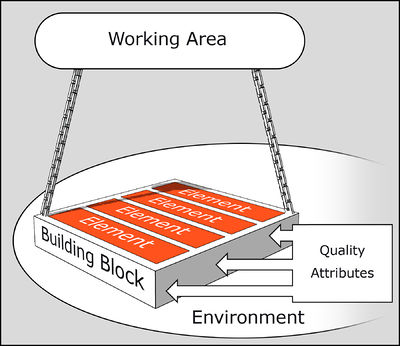OIAm Building Blocks Model structure
| previous: The Infrastructure Quality Attributes | up: table of contents | next: The Building Blocks Model functions and relationships |

Fundamentally, the Building Blocks Model has a functional structure. Building Block types are defined for each type of a logical infrastructure facility. Within a specific organisation or specific environment, several variants of a Building Block type will typically be found.
The Building Blocks Model has the following dimensions/components:
- Working Area. A Working Area defines a commonly recognised area of expertise within the infrastructure domain. The Working Areas in this repository can be found here;
- Environment. In this context, Environment means a functionally demarcated domain within an organisation’s infrastructure landscape. Environments differ from each other primarily in the types of functionality they offer and the way and under what conditions infrastructure facilities are being used. A further subdivision of environments in location types can be made if the facilities provided at each location are so different that it is logical to make a further breakdown. The Environments in this repository can be found here;
- Building Block. A Building Block is a single, logical infrastructure facility that, in the context of an environment, provides uniform and specific infrastructure functionality. Several variants of a certain type of building block may occur within an organisation, depending on the diversity of Environments. The Building Block types in this repository can be found here, Building Block Variants here here;
- Element. Elements are technical components/functions (hardware, software, protocols) used to construct Building Blocks (Variants). The Elements in this repository can be found here;
- Quality Attribute. Quality Attributes determine how a Building Block (Variant) functions. Quality Attributes influence the elements used to construct a Building Block Variant. The Quality Attributes in this repository can be found here;
At street level, you can examine the details of buildings in front of you, but these buildings are in front of other buildings, stopping you from seeing those buildings. It is also impossible to detect the possible relationship between buildings based on their business function. For example, the Main Post Office might be located right behind the Central Train Station for sound business reasons, but I can’t possibly see this if I just stand in front of the Central Train Station. Of course, it is possible to travel from building to building within a city and exhaustively describe every single building and their (business) relationships with the surrounding buildings. This will provide an overwhelming amount of accurate data that will however defeat the objective of providing an overview of the situation. On the other hand, I could choose to use Google Earth and zoom into the city. Google Earth provides me with a quick superficial overview of the positioning of the buildings within this city. All the rooftops are displayed, the structure of the streets is provided, but we learn nothing about the function of these buildings or their characteristics. However, if I were a bird, I could survey a city quickly from several perspectives. I could use the high level (Google Earth) perspective to decide how to divide the city into sections. I could zoom in on a certain section and discover which buildings provide which services within that section and the way those buildings relate to each other. I could even zoom in on particular building to examine how they are constructed (the street level perspective).
The Building Blocks Model brings several dimensions offering the various levels of perspective to allow us to formulate an abstract decomposition and description of an infrastructure landscape — understandable for both business and information architects — that at the same time provides enough depth to make sense to the technicians who must design and build the infrastructure.
| previous: The Infrastructure Quality Attributes | up: table of contents | next: The Building Blocks Model functions and relationships |